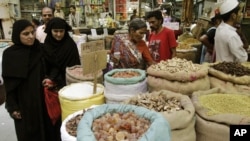Global food commodity prices declined 1.5 percent last month, according to the latest United Nations data.
The U.N. Food and Agriculture Organization’s food price index was down 3 points in November to 211 points.
“Prices began to stabilize, but they’re stabilizing at quite a high level,” says FAO economist Abdolreza Abbassian.
He says the index has been stuck at this level - more than twice the average for 2002-2004 - because global supplies of corn, wheat and soybeans are tight, and drought in the United States and Eastern Europe cut harvests this year.
That raised the cost of livestock feed. Dairy was the one commodity whose prices rose slightly in this month’s index. Meat prices were actually down a little, but FAO says that’s because producers are cutting their profits.
While the grain markets have probably settled down for the year, Abbassian says there may be more trouble ahead for meat and dairy.
“I think these two sectors are going to be much exposed for a longer period of time to the high feed prices that we’ve been experiencing now for over one year,” he says.
Dry weather continues in wheat-growing regions of the U.S. and Eastern Europe, but Abbassian says it’s too early to say what impact that will have on future prices.
Rice is one bright spot in the index. Abbassian says after another good harvest this year, “We have such a good inventory for rice that should next year’s production even fall short of expectations, we should still have a good buffer.”
Most food-insecure countries have not been hit as hard this year as in previous price spikes.
"The high price situation was actually more of a developed-country issue," Abbassian says. "Either [developing countries] had better crops themselves, or exchange rate development," or other factors.
The U.N. Food and Agriculture Organization’s food price index was down 3 points in November to 211 points.
“Prices began to stabilize, but they’re stabilizing at quite a high level,” says FAO economist Abdolreza Abbassian.
Regional Food Security at a Glance
Regional Food Security at a Glance- Prices are up in Southern Africa on disappointing harvests.
- Markets in West Africa were mostly stable but high, and large numbers of people remain displaced by conflict.
- East Africa saw seasonal declines with the new harvest.
- In the Great Lakes, conflict in the Democratic Republic of Congo means more than 6 million people need food assistance, 2 million more than last year.
- In the Middle East, food security concerns are increasing in Syria due to the civil conflict, Yemen remains a trouble spot.
- Wheat prices are up in the countries of the former Soviet Union on poor harvests.
- Prices are up in Haiti due to damage from tropical storms.
He says the index has been stuck at this level - more than twice the average for 2002-2004 - because global supplies of corn, wheat and soybeans are tight, and drought in the United States and Eastern Europe cut harvests this year.
That raised the cost of livestock feed. Dairy was the one commodity whose prices rose slightly in this month’s index. Meat prices were actually down a little, but FAO says that’s because producers are cutting their profits.
While the grain markets have probably settled down for the year, Abbassian says there may be more trouble ahead for meat and dairy.
“I think these two sectors are going to be much exposed for a longer period of time to the high feed prices that we’ve been experiencing now for over one year,” he says.
Dry weather continues in wheat-growing regions of the U.S. and Eastern Europe, but Abbassian says it’s too early to say what impact that will have on future prices.
Rice is one bright spot in the index. Abbassian says after another good harvest this year, “We have such a good inventory for rice that should next year’s production even fall short of expectations, we should still have a good buffer.”
Most food-insecure countries have not been hit as hard this year as in previous price spikes.
"The high price situation was actually more of a developed-country issue," Abbassian says. "Either [developing countries] had better crops themselves, or exchange rate development," or other factors.





